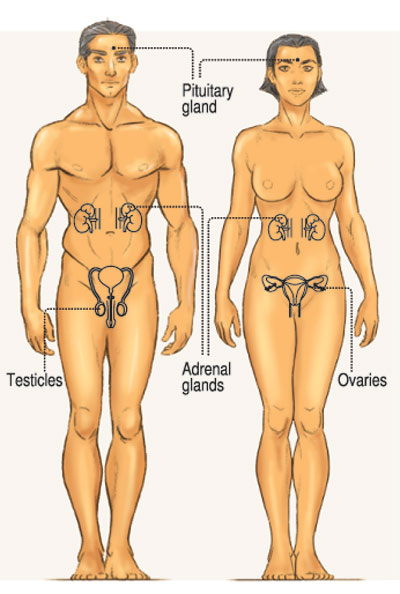Sex hormones: The problem of too high or too low

It is all about sex hormones and controversy rages in the international arena whether star athletes should be tested for them in the light of a ruling that Olympic Gold Medallist sprinter Caster Semenya should take hormone suppressants.
What are sex hormones, how is gender determined and what are the medical conditions that can come about due to these sex hormones being either too high or too low?
This is what MediScene zeroed in on during an extensive interview with Consultant Endocrinologist Dr. Uditha Bulugahapitiya, who heads the Colombo South (Kalubowila) Teaching Hospital’s Diabetes & Endocrine Unit.

Dr Uditha Bulugahapitiya
Explaining that sex hormones are crucial in sexual development and reproduction, he categorizes the ‘main’ sex hormones in females as oestrogen and progesterone and in males as testosterone.
Oestrogen and progesterone are produced in the ovaries, adrenal glands and in pregnancy in the placenta, while testosterone is produced in the testicles as well as small amounts in the adrenal glands, MediScene learns.
However, both females and males have the opposite gender’s hormones in small quantities, points out Dr. Bulugahapitiya, citing the example of testosterone, a steroid hormone, a small quantity of which is produced in a female’s ovaries.
“It is very important for both males and females not only to have the relevant sex hormone during puberty when they are the drivers of physical change but also to have ‘optimal’ levels throughout adulthood and also in old age,” he says.
However, there are several medical conditions linked to sex hormones and this Endocrinologist assures that they can be treated and corrected.
These conditions include:
A female who has a higher level than necessary of the male hormone, testosterone –
Symptoms:
No menstruation (periods) or irregular menstruation.
Pimples on the face.
Male-pattern hair distribution such as a beard and on the chest.
Male-pattern hair loss and temporal recession of the hairline and baldness
A more muscular rather than fatty body.
Gaining a deeper male voice.
 This could occur due to Polycystic Ovary Syndrome (PCOS), which is quite common or because of a tumour in the ovary or in the adrenal glands, which is just above the kidneys. These females would have a higher chance of becoming obese and having diabetes.
This could occur due to Polycystic Ovary Syndrome (PCOS), which is quite common or because of a tumour in the ovary or in the adrenal glands, which is just above the kidneys. These females would have a higher chance of becoming obese and having diabetes.
While high levels of testosterone due to PCOS usually starts at menarche (the first occurrence of menstruation), Dr. Bulugahapitiya assures that this condition can be treated and the symptoms reduced. When the time comes, the female can also have a normal pregnancy. In addition to the treatment, there would also be a need for weight reduction and maintenance of normal weight.
A tumour either in the ovaries or the adrenal glands could also cause a secretion of androgens (hormones such as testosterone). This would have a short history with more severe symptoms. Investigations to confirm the tumour would then be carried out and the tumour removed. Rarely, such a tumour could be cancerous, causing high levels of testosterone.
A female could also have low levels of oestrogen, which can come about either during childhood or even later in life. This could be due to a congenital (genetic) problem leading to an isolated growth hormone deficiency or pituitary hormone deficiency and cause the elevation of the levels of other hormones such as prolactin (hyperprolactinemia) or hypothyroidism (underactive thyroid). This can prevent the woman from getting pregnant.
The symptoms in girlhood would include:
Not reaching puberty (the period during which adolescents reach sexual maturity and become capable of reproduction).
No breast development or normal menstruation.
No female features of body shape or voice.
The symptoms in later life, womanhood, would include:
Premature menopause – usually, menopause occurs when a woman reaches the age of 45-50 years.
Hot flushes and sweating.
With time breast atrophy, low interest in sex and pain when engaging in sexual activity.
Loss of female pattern of hair distribution.
In the elderly, skin becomes taut and wrinkled and bones can get affected resulting in osteoporosis, leading to fractures.
Dr. Bulugahapitiya explains that these symptoms can be overcome through hormone replacement therapy (HRT), while if the patient is younger and needs to have a child, she could resort to Assisted Reproductive Technology (ART).
| Reasons for low testosterone levelsMany could be the contributory factors for a male to have low testosterone levels.The causes include isolated male hormone deficiency, multiple pituitary hormone deficiency or a pituitary tumour, all of which can be treated medically or surgically, says Dr. Uditha Bulugahapitiya, explaining that there could also be an elevation of hormones such as prolactin and hypothyroidism. He assures that such patients can be given hormone replacement therapy (HRT) to get secondary sexual characteristics, while if they wish to have children they could be guided in the direction of Assisted Reproductive Technology (ART). The symptoms of low testosterone levels in a male are: Not reaching puberty. Pointing out that a testosterone deficiency can occur in a male at any age, he says that one indicator would be the facial hair of the affected person reducing or that person not producing any facial hair. Dr. Bulugahapitiya says that this too could occur at any age and will present symptoms such as: | |


